Lower-Limb Flexibility Profile in 142 Competitive Female Football Players: A Cross-Sectional Study
Abstract
1. Introduction
2. Materials and Methods
2.1. Design
2.2. Sample of Female Football Players
2.3. Procedures
2.4. Statistical Analysis
3. Results
4. Discussion
Limitations
5. Conclusions
Author Contributions
Funding
Institutional Review Board Statement
Informed Consent Statement
Data Availability Statement
Acknowledgments
Conflicts of Interest
References
- Cejudo, A. Description of ROM-SPORT I Battery: Keys to Assess Lower Limb Flexibility. Int. J. Environ. Res. Public Health 2022, 19, 10747. [Google Scholar] [CrossRef] [PubMed]
- Ayala, F.; López-Valenciano, A.; Gámez Martín, J.; De Ste Croix, M.; Vera-Garcia, F.; García-Vaquero, M.; Ruiz-Pérez, I.; Myer, G. A Preventive Model for Hamstring Injuries in Professional Soccer: Learning Algorithms. Int. J. Sports Med. 2019, 40, 344–353. [Google Scholar] [CrossRef]
- Ruiz-Pérez, I.; López-Valenciano, A.; Hernández-Sánchez, S.; Puerta-Callejón, J.; De Ste Croix, M.; Sainz de Baranda, P.; Ayala, F. A Field-Based Approach to Determine Soft Tissue Injury Risk in Elite Futsal Using Novel Machine Learning Techniques. Front. Psychol. 2021, 12, 195. [Google Scholar] [CrossRef]
- López-Valenciano, A.; Ayala, F.; Puerta, J.; Croix, M.; Vera-García, F.; Hernández-Sánchez, S.; Myer, G. A preventive model for muscle injuries: A novel approach based on learning algorithms. Med. Sci. Sports Exerc. 2018, 50, 915–927. [Google Scholar] [CrossRef]
- Cejudo, A.; Armada-Zarco, J.; Ayala, F.; Sainz de Baranda, P. Prediction of ACL-tear by lower limbs muscle strength and flexibility: A prospective cohort study in 95 female soccer players. Res. Sports Med. 2024, 32, 820–842. [Google Scholar] [CrossRef]
- Arnason, A.; Sigurdsson, S.; Gudmundsson, A.; Holme, I.; Engebretsen, L.; Bahr, R. Risk Factors for Injuries in Football. Am. J. Sports Med. 2004, 32, 5S–16S. [Google Scholar] [CrossRef]
- Hägglund, M.; Waldén, M. Risk factors for acute knee injury in female youth football. Knee Surg. Sports Traumatol. Arthrosc. 2016, 24, 737–746. [Google Scholar] [CrossRef]
- Östenberg, A.; Roos, H. Injury risk factors in female European football. A prospective study of 123 players during one season. Scand. J. Med. Sci. Sports 2000, 10, 279–285. [Google Scholar] [CrossRef]
- Söderman, K.; Alfredson, H.; Pietilä, T.; Werner, S.; Söderman, K.; Alfredson, H.; Pietilä, T.; Alfredson, H.; Werner, S. Risk factors for leg injuries in female soccer players: A prospective investigation during one out-door season. Knee Surg. Sports Traumatol. Arthrosc. 2001, 9, 313–321. [Google Scholar] [CrossRef]
- Faude, O.; Junge, A.; Kindermann, W.; Dvorak, J. Risk factors for injuries in elite female soccer players. Br. J. Sports Med. 2006, 40, 785–790. [Google Scholar] [CrossRef]
- Niyonsenga, J.; Phillips, J. Factors associated with injuries among first-division Rwandan female soccer players. Afr. Health Sci. 2013, 13, 1021–1026. [Google Scholar] [CrossRef]
- Sainz de Baranda, P.; Cejudo, A.; Ayala, F.; Santonja, F. Perfil óptimo de flexibilidad del miembro inferior en jugadoras de fútbol sala. Rev. Int. De Med. Y Cienc. De La Act. Fisica y del Deporte 2015, 15, 647–662. [Google Scholar] [CrossRef][Green Version]
- López-Valenciano, A.; Ayala, F.; Vera-García, F.; De Ste Croix, M.; Hernández-Sánchez, S.; Ruiz-Pérez, I.; Cejudo, A.; Santonja, F. Comprehensive profile of hip, knee and ankle ranges of motion in professional football players. J. Sports Med. Phys. Fit. 2019, 59, 102–109. [Google Scholar] [CrossRef] [PubMed]
- Mosler, A.; Crossley, K.; Thorborg, K. Hip strength and range of motion: Normal values from a professional football league. J. Sci. Med. Sport 2017, 20, 339–343. [Google Scholar] [CrossRef]
- Heijboer, W.; Thijs, K.; Weir, A.; Serner, A.; Tol, J.; Goedhart, E.; Groot, F. Normal hip strength and range of motion values in youth and adult female national football teams: Data from 504 assessments. Phys. Ther. Sport 2024, 69, 51–58. [Google Scholar] [CrossRef]
- Tak, I.; Langhout, R.; Groters, S.; Weir, A.; Stubbe, J.; Kerkhoffs, G. A new clinical test for measurement of lower limb specific range of motion in football players: Design, reliability and reference findings in non-injured players and those with long-standing adductor-related groin pain. Phys. Ther. Sport 2017, 23, 67–74. [Google Scholar] [CrossRef]
- Magee, D. Orthopedic Physical Assessment; Elsevier Health Sciences: Philadelphia, PA, USA, 2013. [Google Scholar]
- McMahon, J.J.; Ripley, N.J.; Comfort, P. Force plate-derived countermovement jump normative data and benchmarks for professional rugby league players. Sensors 2022, 22, 8669. [Google Scholar] [CrossRef]
- Turner, A.; Jones, B.; Stewart, P.; Bishop, C. Total score of athleticism: Holistic athlete profiling to enhance decision-making. Strength Cond. J. 2019, 41, 91–101. [Google Scholar] [CrossRef]
- Lockie, R.; Risso, F.; Giuliano, D.; Orjalo, A.; Jalilvand, F. Practical fitness profiling using field test data for female elite-level collegiate soccer players: A case analysis of a Division I Team. Strength Cond. J. 2018, 40, 58–71. [Google Scholar] [CrossRef]
- Gogia, P.; Braatz, J.; Rose, S.; Norton, B. Reliability and Validity of Goniometric Measurements at the Knee. Phys. Ther. 1987, 67, 192–195. [Google Scholar] [CrossRef]
- Enwemeka, C. Radiographic verification of knee goniometry. Scand. J. Rehabil. Med. 1986, 18, 47–49. [Google Scholar] [CrossRef] [PubMed]
- Gerhardt, J.; Cocchiarella, L.; Lea, R. The Practical Guide to Range of Motion Assessment; American Medical Association: Chicago, IL, USA, 2002. [Google Scholar]
- Surgeons American Academy of Orthopaedic. Joint Motion: Method of Measuring and Recording; Churchill Livingstone: Chicago, IL, USA, 1965. [Google Scholar]
- Cejudo, A.; Sainz de Baranda, P.; Ayala, F.; Santonja, F. Test-retest reliability of seven common clinical tests for assessing lower extremity muscle flexibility in futsal and handball players. Phys. Ther. Sport 2015, 16, 107–113. [Google Scholar] [CrossRef] [PubMed]
- Cejudo, A.; Sainz de Baranda, P.; Ayala, F.; De Ste Croix, M.; Santonja-Medina, F. Assessment of the Range of Movement of the Lower Limb in Sport: Advantages of the ROM-SPORT I Battery. Int. J. Environ. Res. Public Health 2020, 17, 7606. [Google Scholar] [CrossRef]
- Taylor, K.; Sheppard, J.; Hamilton, L.; Plummer, N. Negative effect of static stretching restored when combined with a sport specific warm-up component. J. Sci. Med. Sport 2009, 12, 657–661. [Google Scholar] [CrossRef]
- Robertson, S.; Bartlett, J.; Gastin, P. Red, Amber, or Green? Athlete Monitoring in Team Sport: The Need for Decision-Support Systems. Int. J. Sports Physiol. Perform. 2016, 12, S273–S279. [Google Scholar] [CrossRef]
- De la Fuente, A.; Gómez-Landero, L. Motor differences in cadet taekwondo athletes according to competition level. Rev. Int. De Med. Y Cienc. De La Act. Fisica y del Deporte 2019, 19, 63–75. [Google Scholar] [CrossRef]
- Battista, R.; Pivarnik, J.; Dummer, G.; Sauer, N.; Malina, R. Comparisons of physical characteristics and performances among female collegiate rowers. J. Sports Sci. 2007, 25, 651–657. [Google Scholar] [CrossRef]
- Manning, C.; Hudson, Z. Comparison of hip joint range of motion in professional youth and senior team footballers with age-matched controls: An indication of early degenerative change? Phys. Ther. Sport 2009, 10, 25–29. [Google Scholar] [CrossRef]
- Hackett, D.; He, W.; Tran, D.; Sanders, R. Effects of age and playing position on field-based physical fitness measures in adolescent female soccer players. J. Sports Med. Phys. Fit. 2024, 64, 889–897. [Google Scholar] [CrossRef]
- Ganse, B.; Degens, H. Current Insights in the Age-related Decline in Sports Performance of the Older Athlete. Int. J. Sports Med. 2021, 42, 879–888. [Google Scholar] [CrossRef]
- Nikolaidis, P. Physical fitness in female soccer players by player position: A focus on anaerobic power. Hum. Mov. 2014, 15, 74–79. [Google Scholar] [CrossRef]
- Fältström, A.; Skillgate, E.; Tranaeus, U.; Weiss, N.; Källberg, H.; Lyberg, V.; Nomme, M.; Thome, N.; Omsland, T.; Pedersen, E.; et al. Normative values and changes in range of motion, strength, and functional performance over 1 year in adolescent female football players: Data from 418. Phys. Ther. Sport 2022, 58, 106–116. [Google Scholar] [CrossRef] [PubMed]
- López-Valenciano, A.; Ayala, F.; De Ste Croix, M.; Barbado, D.; Vera-Garcia, F. Different neuromuscular parameters influence dynamic balance in male and female football players. Knee Surg. Sports Traumatol. Arthrosc. 2019, 27, 962–970. [Google Scholar] [CrossRef]
- Alimoradi, M.; Sahebozamani, M.; Hosseini, E.; Konrad, A.; Noorian, S. The effect on flexibility and a variety of performance tests of the addition of 4 weeks of soleus stretching to a regular dynamic stretching routine in amateur female. Sports 2023, 11, 138. [Google Scholar] [CrossRef]
- García-Pinillos, F.; Ruiz-Ariza, A.; Moreno del Castillo, R.; Latorre-Román, P. Impact of limited hamstring flexibility on vertical jump, kicking speed, sprint, and agility in young football players. J. Sports Sci. 2015, 33, 1293–1297. [Google Scholar] [CrossRef]
- Oliveira, A.; Barbieri, F.; Gonçalves, M. Flexibility, torque and kick performance in soccer: Effect of dominance. Sci. Sports 2013, 28, 67–70. [Google Scholar] [CrossRef]
- Tainaka, K.; Takizawa, T.; Kobayashi, H.; Umimura, M. Limited hip rotation and non-contact anterior cruciate ligament injury: A case–control study. Knee 2014, 21, 86–90. [Google Scholar] [CrossRef]
- Weaver, K.; Relph, N. An assessment of clinical joint and limb measures in professional female soccer players: Screening tools for injury prevention? Br. J. Sports Med. 2017, 51, 406–407. [Google Scholar] [CrossRef]
- Nilsson, T.; Östenberg, A.; Alricsson, M. Injury profile among elite male youth soccer players in a Swedish first league. J. Exerc. Rehabil. 2016, 12, 83–89. [Google Scholar] [CrossRef]
- Xu, D.; Zhou, H.; Quan, W.; Ma, X.; Chon, T.; Fernandez, J.; Gusztav, F.; Kovács, A.; Baker, J.; Gu, Y. New insights optimize landing strategies to reduce lower limb injury risk. Cyborg Bionic Syst. 2024, 5, 0126. [Google Scholar] [CrossRef]
- Konrad, A.; Tilp, M. Effects of ballistic stretching training on the properties of human muscle and tendon structures. J. Appl. Physiol. 2014, 117, 29–35. [Google Scholar] [CrossRef]
- Behm, D.; Blazevich, A.; Kay, A.; McHugh, M. Acute effects of muscle stretching on physical performance, range of motion, and injury incidence in healthy active individuals: A systematic review. Appl. Physiol. Nutr. Metab. 2015, 41, 1–11. [Google Scholar] [CrossRef] [PubMed]
- Nishikawa, Y.; Aizawa, J.; Kanemura, N.; Takahashi, T.; Hosomi, N.; Maruyama, H.; Kimura, H.; Matsumoto, M.; Takayanagi, K. Immediate effect of passive and active stretching on hamstrings flexibility: A single-blinded randomized control trial. J. Phys. Ther. Sci. 2015, 27, 3167–3170. [Google Scholar] [CrossRef] [PubMed]
- Sharman, M.; Cresswell, A.; Riek, S. Proprioceptive Neuromuscular Facilitation Stretching Mechanisms and Clinical Implications. Sports Med. 2006, 36, 929–939. [Google Scholar] [CrossRef] [PubMed]
- Nelson, R.; Bandy, W. Eccentric Training and Static Stretching Improve Hamstring Flexibility of High School Males. J. Athl. Train. 2004, 39, 254. [Google Scholar]
- Cai, P.; Liu, L.; Li, H. Dynamic and static stretching on hamstring flexibility and stiffness: A systematic review and meta-analysis. Heliyon 2023, 9, e18795. [Google Scholar] [CrossRef]
- Robles-Palazón, F.; Blázquez-Rincón, D.; López-Valenciano, A.; Comfort, P.; López-López, J.; Ayala, F. A systematic review and network meta-analysis on the effectiveness of exercise-based interventions for reducing the injury incidence in youth team-sport players. Part 1: An analysis by classical training components. Ann. Med. 2024, 56, 1–28. [Google Scholar] [CrossRef]
- Alentorn-Geli, E.; Myer, G.; Silvers, H.; Samitier, G.; Romero, D.; Lázaro-Haro, C.; Cugat, R. Prevention of non-contact anterior cruciate ligament injuries in soccer players. Part 2: A review of prevention programs aimed to modify risk factors and to reduce injury rates. Knee Surg. Sports Traumatol. Arthrosc. 2009, 17, 859–879. [Google Scholar] [CrossRef]
- Amiri-Khorasani, M.; Gulick, D. Acute effects of different stretching methods on static and dynamic balance in female football players. Int. J. Ther. Rehabil. 2015, 22, 68–73. [Google Scholar] [CrossRef]
- Ltifi, M.; Jlid, M.; Coquart, J.; Maffulli, N.; van den Tillaar, R.; Aouadi, R. Acute Effect of Four Stretching Protocols on Change of Direction in U-17 Male Soccer Players. Sports 2023, 11, 165. [Google Scholar] [CrossRef]
- Rodríguez, C.; Echegoyen, S.; Aoyama, T. The effects of “prevent injury and enhance performance program” in a female soccer team. J. Sports Med. Phys. Fit. 2018, 58, 659–663. [Google Scholar] [CrossRef] [PubMed]
- Emery, C.; Meeuwisse, W. The effectiveness of a neuromuscular prevention strategy to reduce injuries in youth soccer: A cluster-randomised controlled trial. Br. J. Sports Med. 2010, 44, 555–562. [Google Scholar] [CrossRef]
- Azuma, N.; Someya, F. Injury prevention effects of stretching exercise intervention by physical therapists in male high school soccer players. Scand. J. Med. Sci. Sports 2020, 30, 2178–2192. [Google Scholar] [CrossRef]
- Hernandez-Martinez, J.; Ramirez-Campillo, R.; Vera-Assaoka, T.; Castillo-Cerda, M.; Carter-Truillier, B.; Herrera-Valenzuela, T.; López-Fuenzalida, A.; Nobari, H.; Valdés-Badilla, P. Warm-up stretching exercises and physical performance of youth soccer players. Front. Physiol. 2023, 14, 1127669. [Google Scholar]
- Hewett, T.; Lindenfeld, T.; Riccobene, J.; Noyes, F. The effect of neuromuscular training on the incidence of knee injury in female athletes. Am. J. Sports Med. 1999, 27, 699–706. [Google Scholar] [CrossRef]
- Weldon, A.; Duncan, M.; Turner, A.; Lockie, R.; Loturco, I. Practices of strength and conditioning coaches in professional sports: A systematic review. Biol. Sport 2022, 39, 715–726. [Google Scholar] [CrossRef]
- Hopkins, W. How to interpret changes in an athletic performance test. Sport Sci. 2004, 8, 1–7. [Google Scholar]
- Hopkins, W.; Marshall, S.; Batterham, A.; Hanin, J. Progressive Statistics for Studies in Sports Medicine and Exercise Science. Med. Sci. Sports Exerc. 2009, 41, 3–12. [Google Scholar] [CrossRef]
- Dixon, J.; Keating, J. Variability in straight leg raise measurements. Physiotherapy 2000, 86, 361–370. [Google Scholar] [CrossRef]
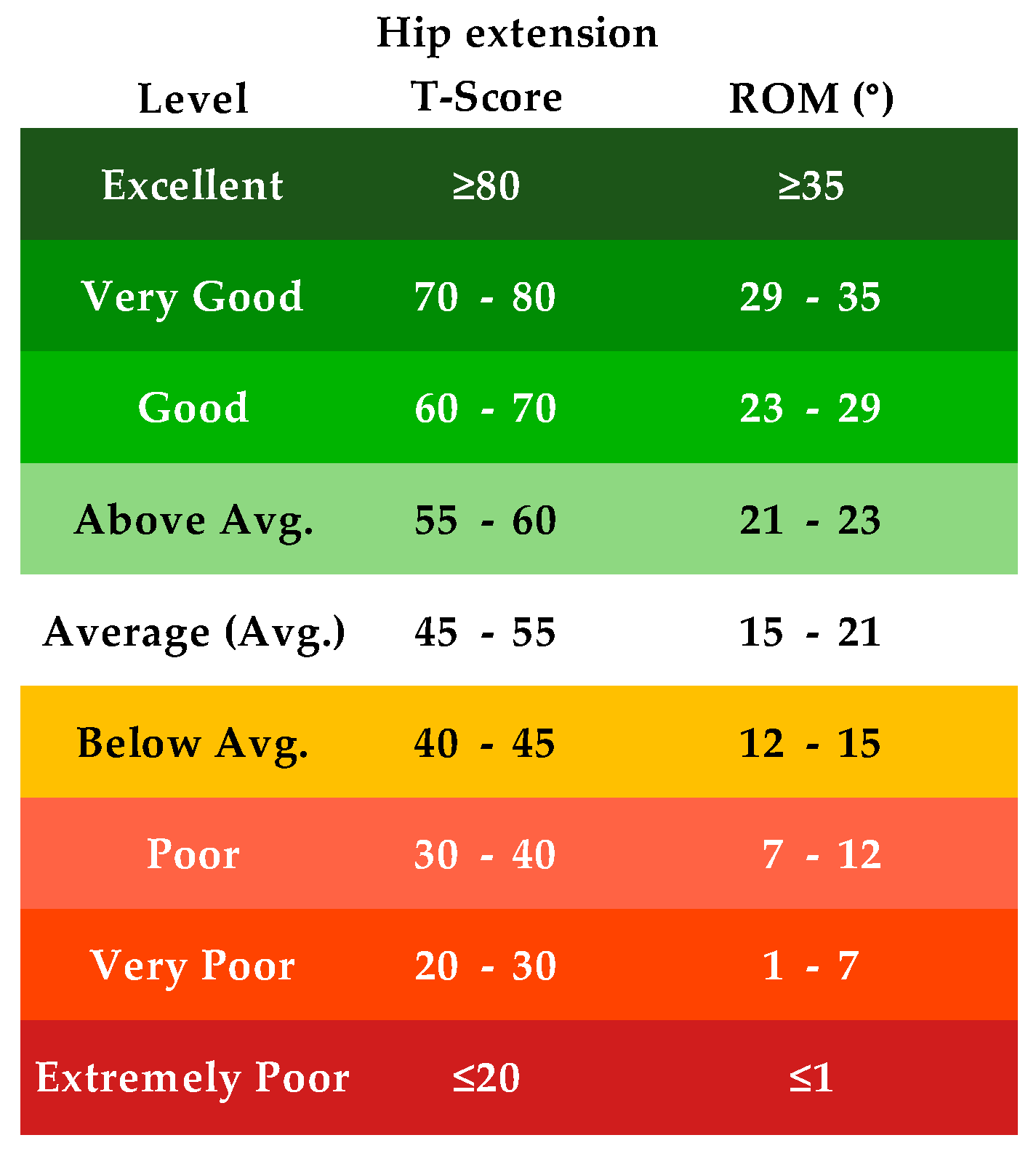
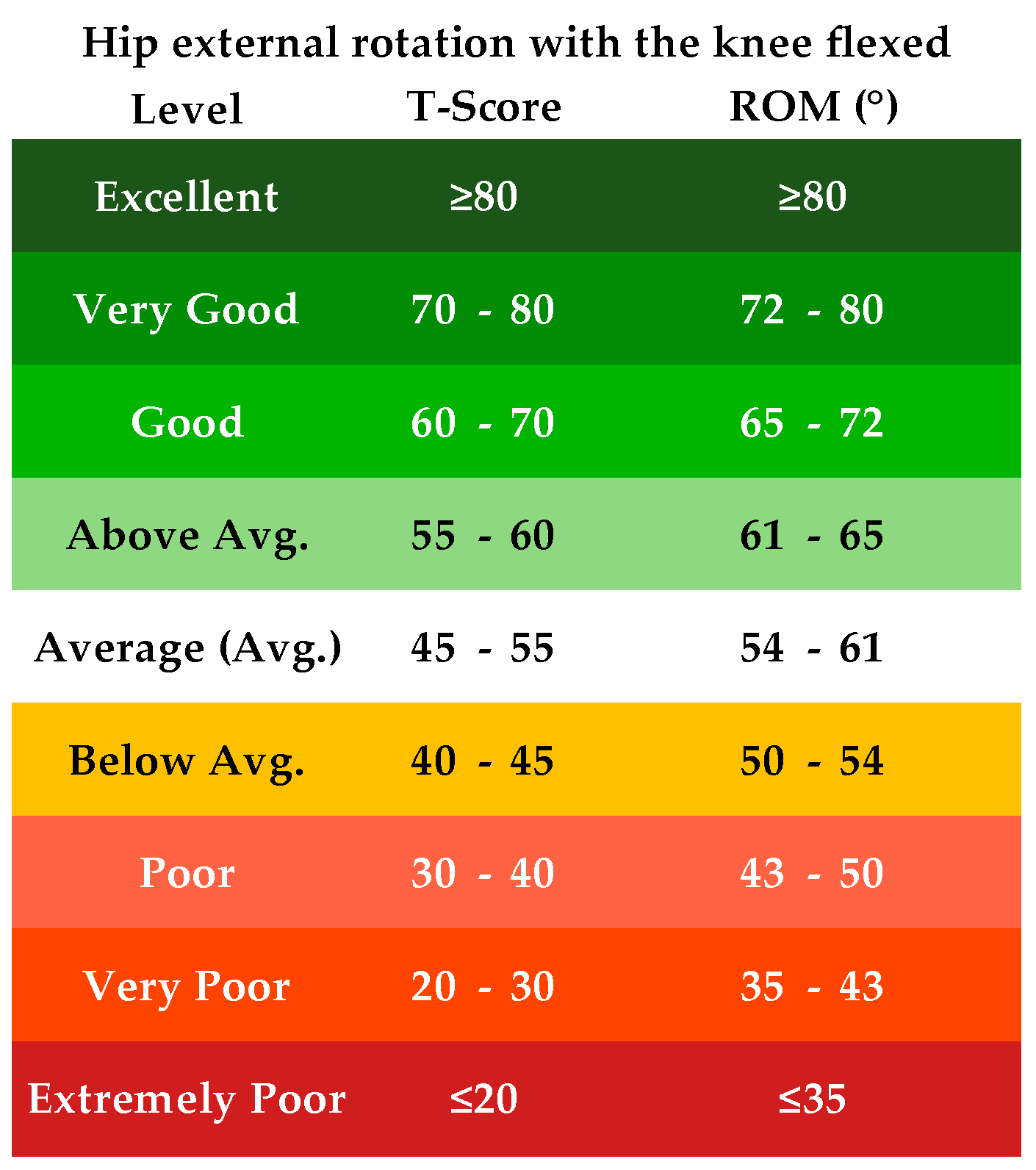
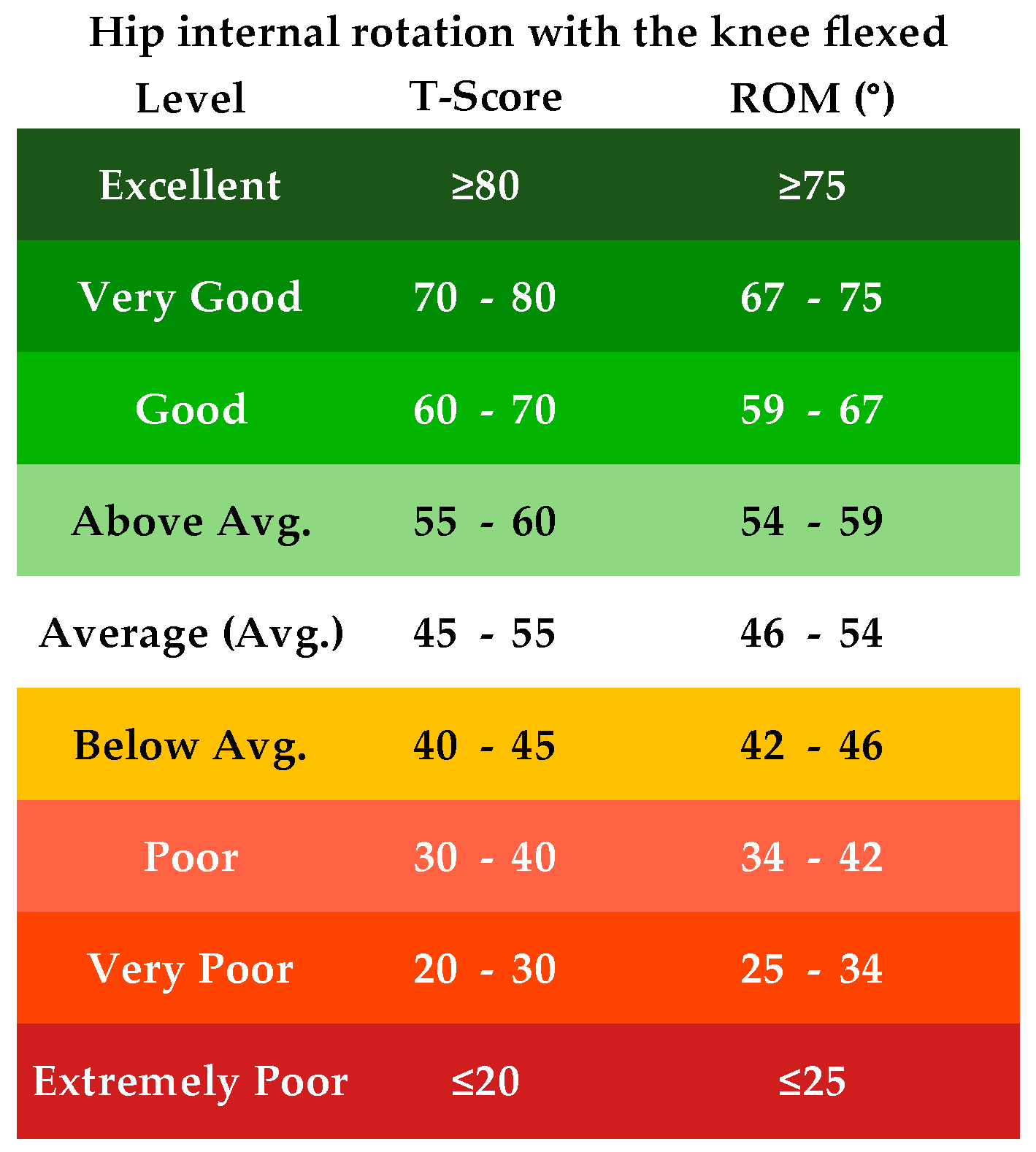
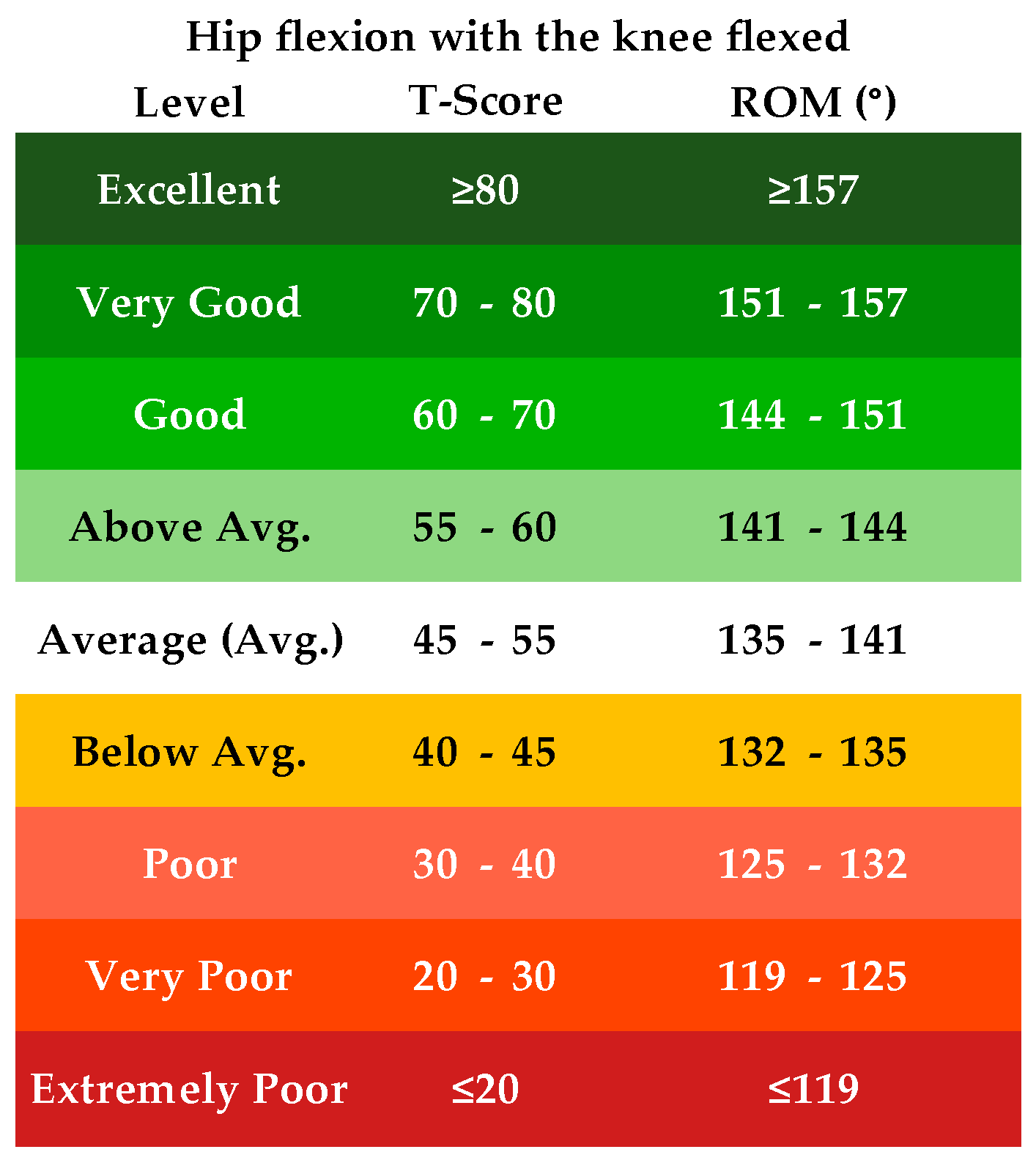
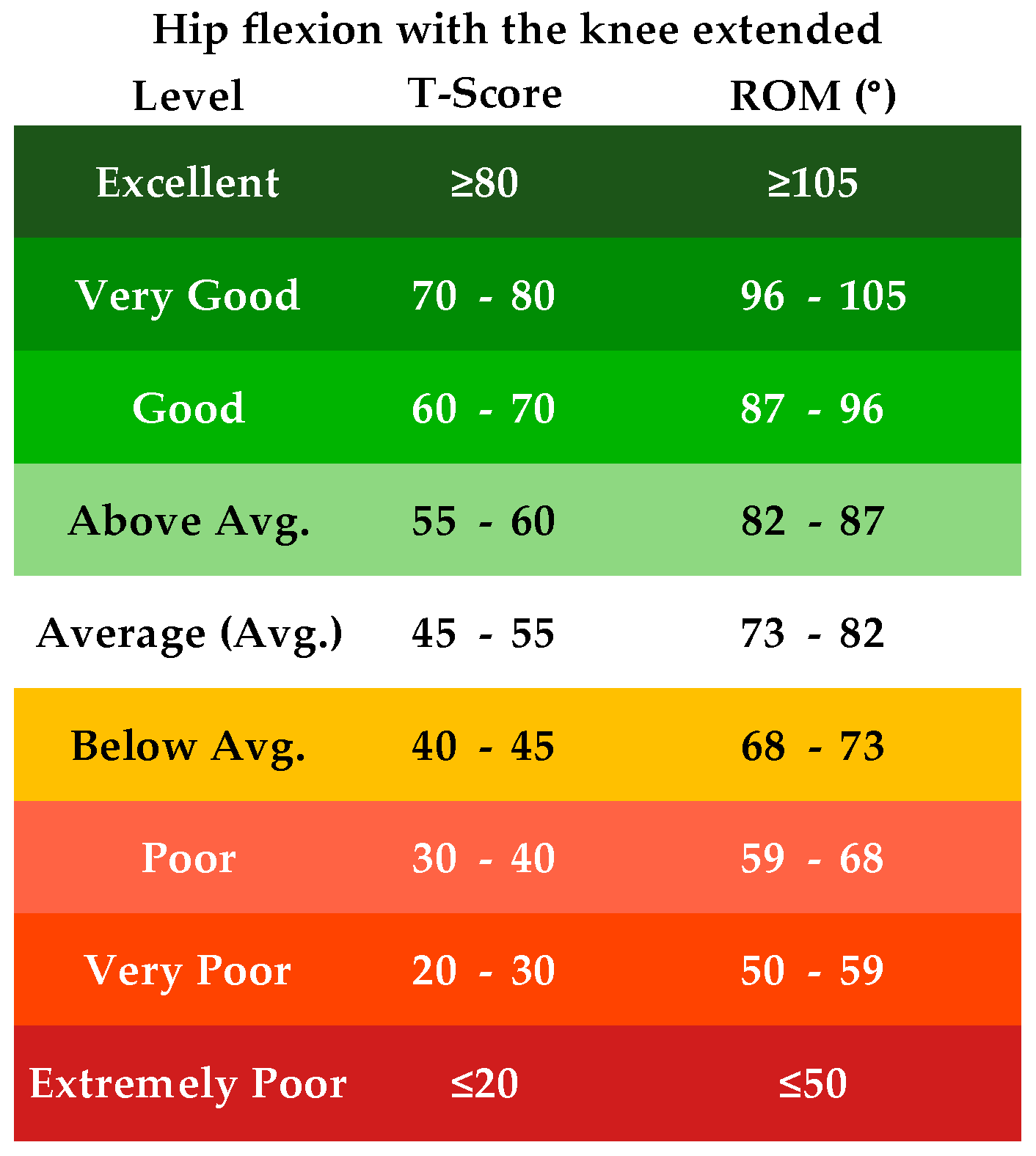
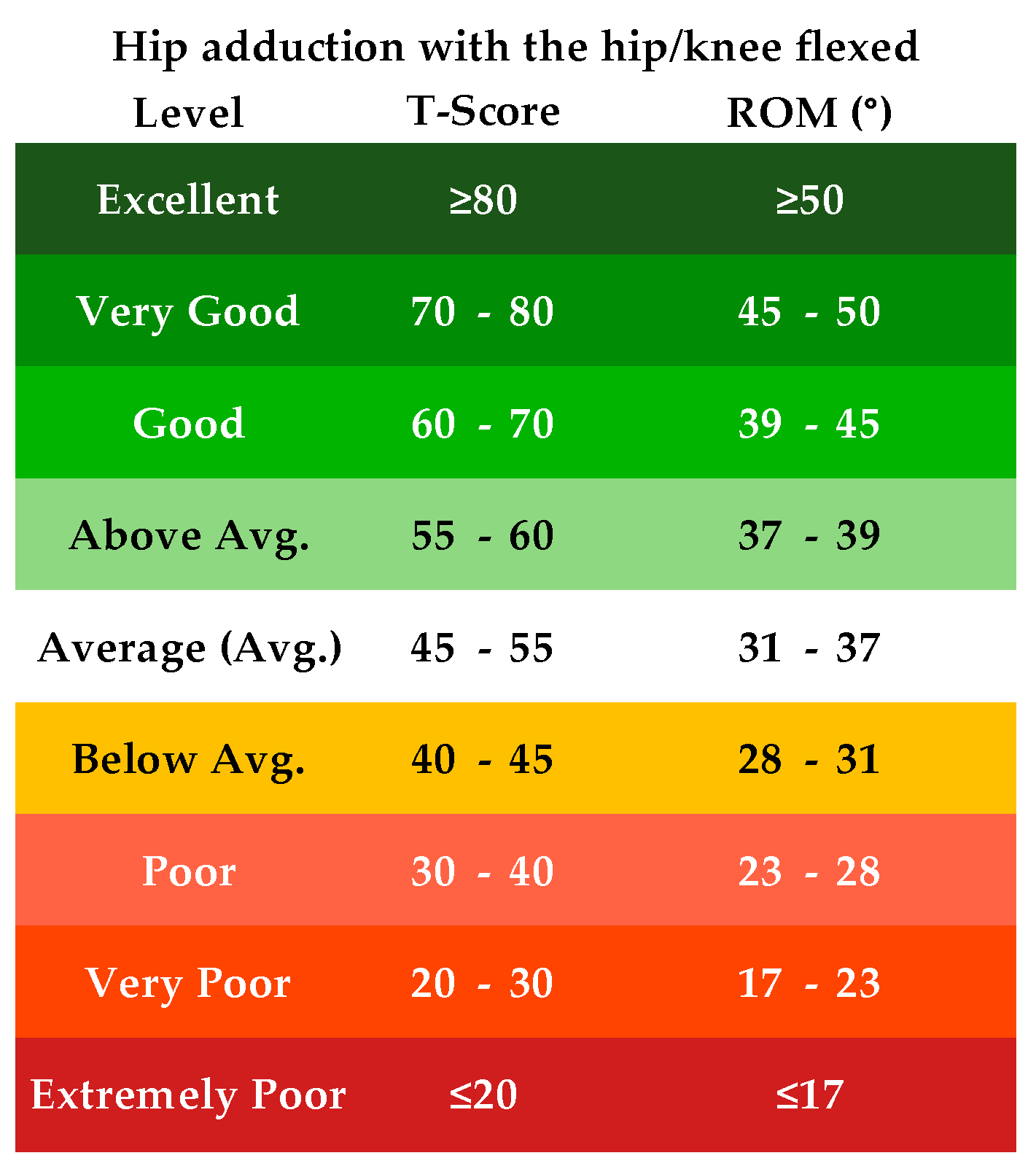
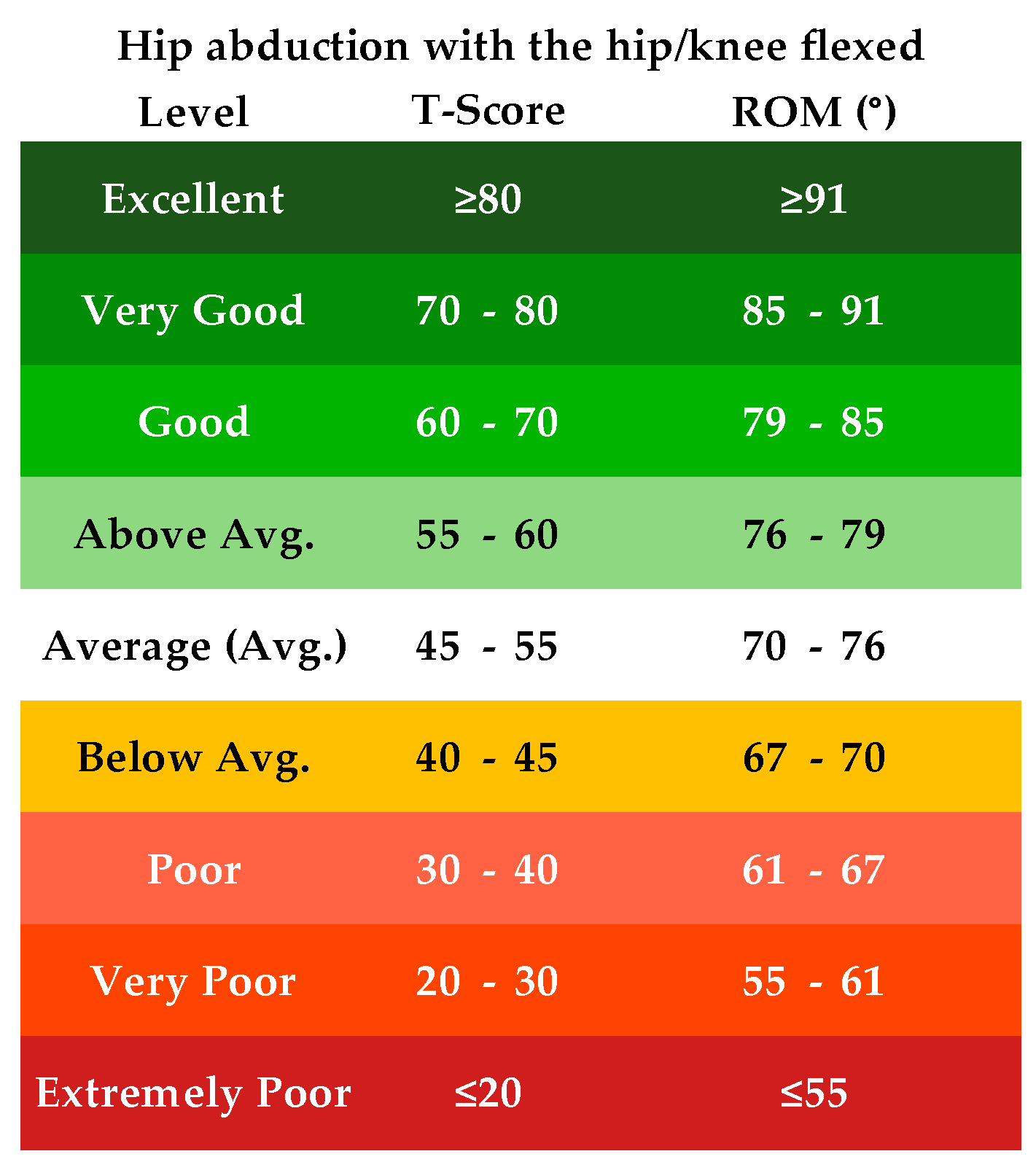
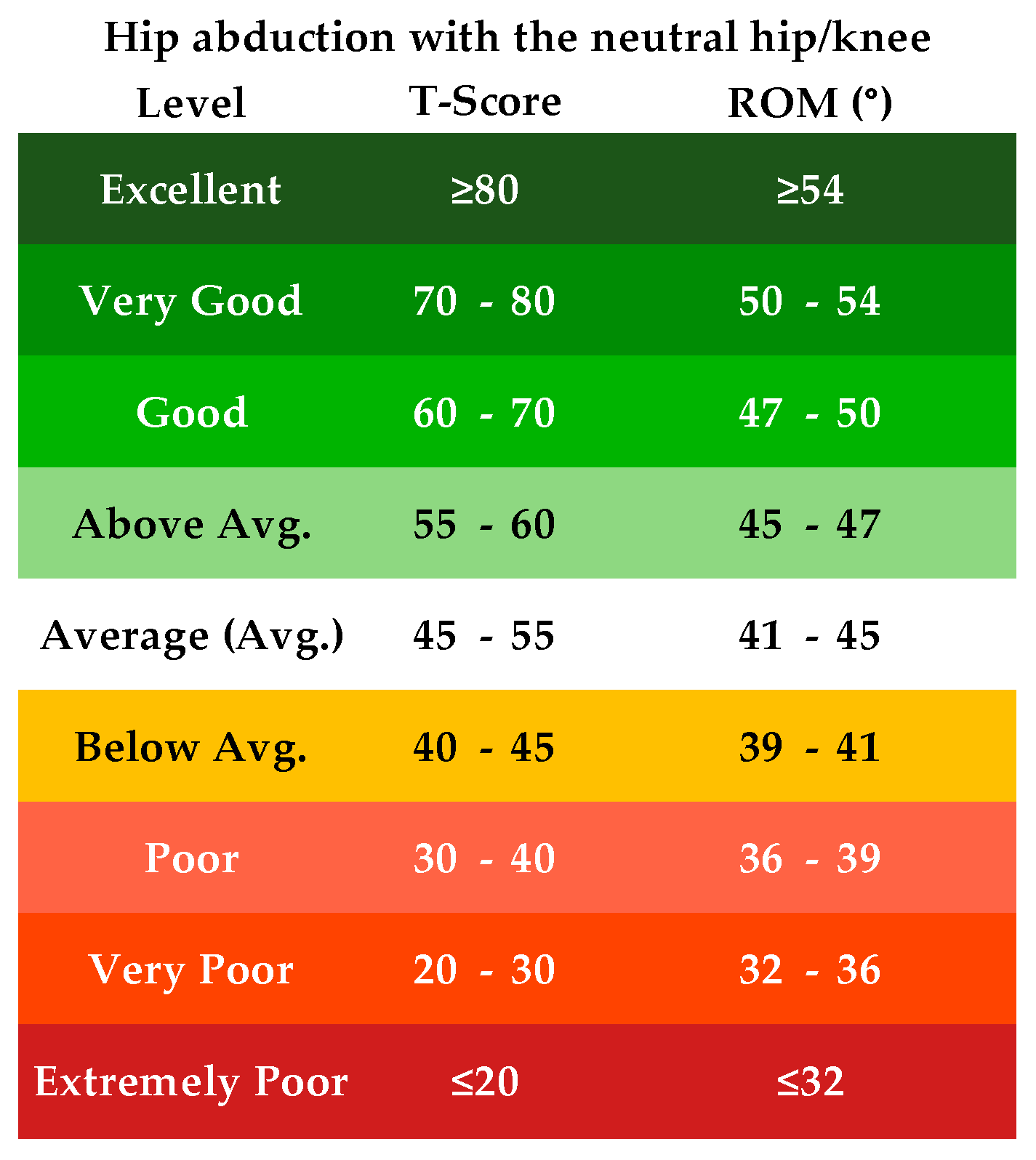
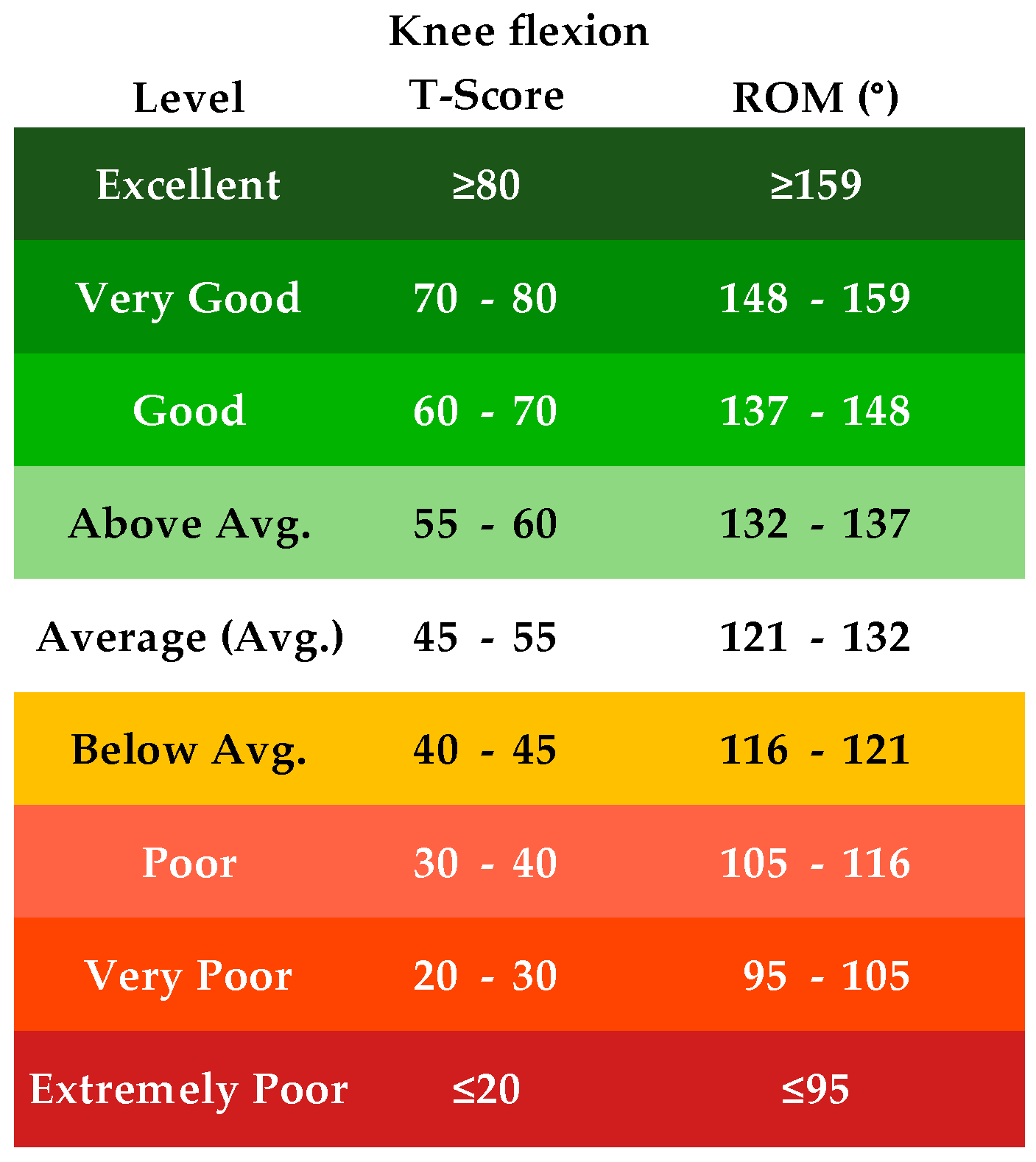
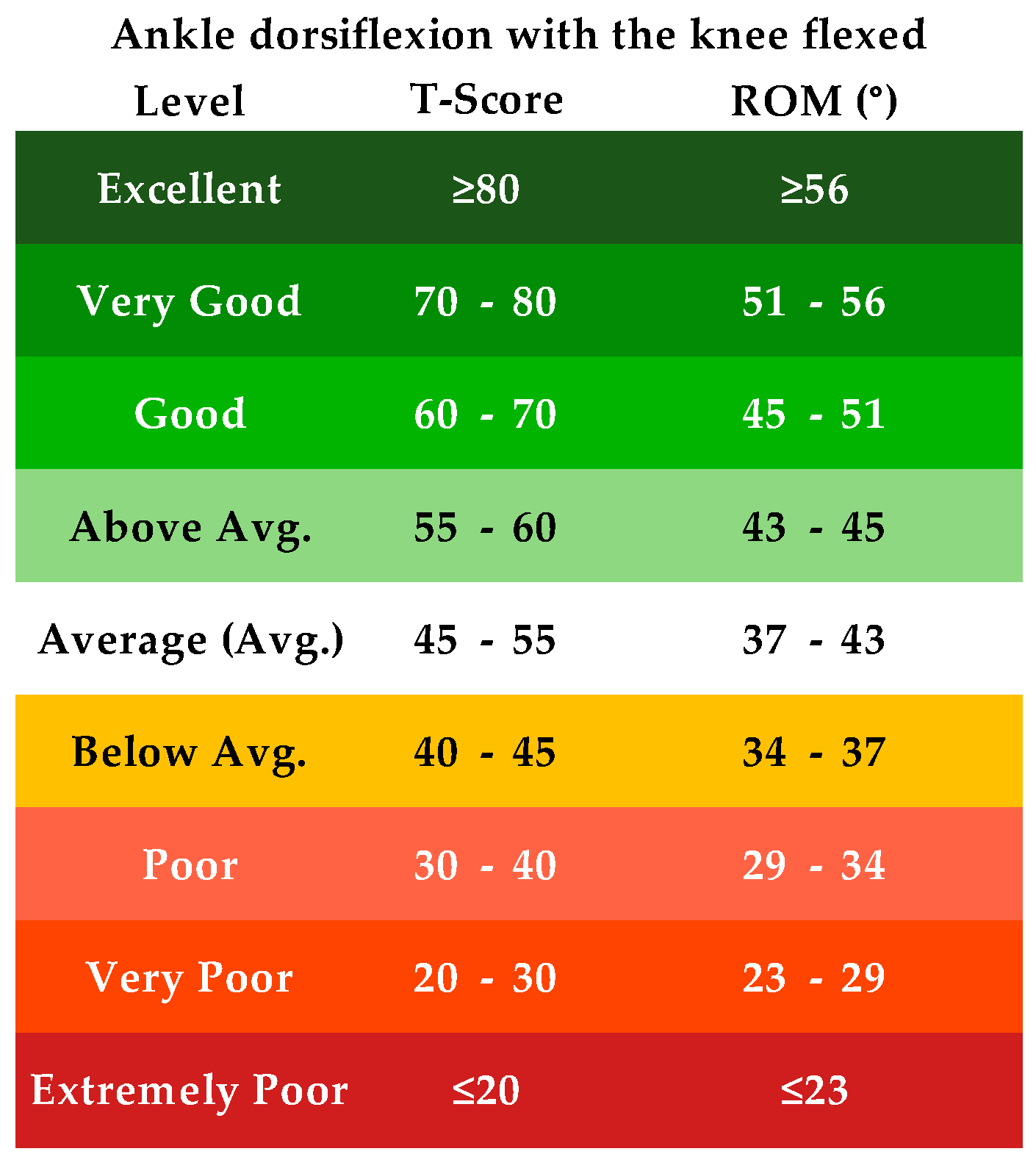
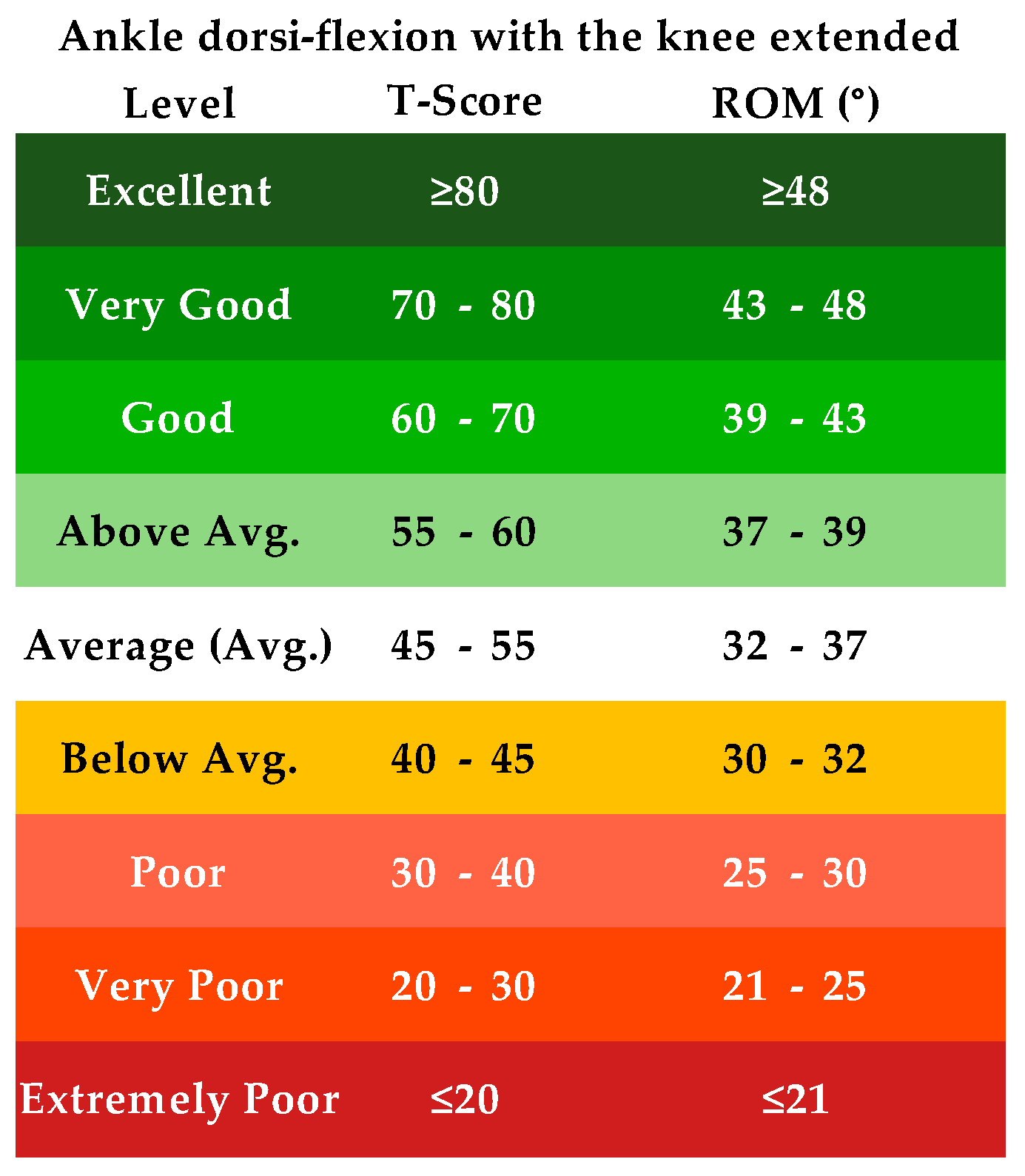
| Variables | Regional League (n = 87) | National League (n = 36) | First Division League (n = 19) | BF10 (Error %) |
|---|---|---|---|---|
| Age (year) | 17.94 ± 4.86 | 20.47 ± 2.74 | 21.84 ± 3.55 1 | 140.93 (0.02) |
| Weight (kg) | 57.46 ± 7.41 | 58.84 ± 7.23 | 57.24 ± 5.97 | 0.13 (0.03) |
| Height (cm) | 161.61 ± 5.10 | 162.76 ± 5.84 | 161.85 ± 5.24 | 0.14 (0.03) |
| BMI (kg/m2) | 22.02 ± 2.83 | 22.22 ± 2.54 | 21.80 ± 1.33 | 0.10 (0.03) |
| HE (degree) | 19.31 ± 6.11 | 14.92 ± 3.67 1 | 16.42 ± 3.53 | 246.80 (0.02) |
| HER (degree) | 58.45 ± 8.04 | 56.94 ± 6.43 | 55.00 ± 5.81 | 0.40 (0.03) |
| HIR (degree) | 52.43 ± 7.70 | 45.89 ± 8.17 1 | 49.00 ± 8.09 | 173.80 (0.02) |
| HF_KF (degree) | 138.55 ± 6.70 | 137.50 ± 5.18 | 136.26 ± 5.91 | 0.23 (0.03) |
| HF_KE (degree) | 78.08 ± 8.77 | 79.40 ± 10.51 | 72.53 ± 7.27 1,2 | 1.53 (0.01) |
| HAD_HKF (degree) | 33.61 ± 5.18 | 32.31 ± 5.85 | 37.84 ± 7.74 1,2 | 18.07 (0.01) |
| HAB_HKF (degree) | 73.59 ± 6.15 | 71.67 ± 6.58 | 72.89 ± 4.75 | 0.26 (0.03) |
| HAB_NHK (degree) | 42.43 ± 3.54 | 43.03 ± 3.74 | 44.79 ± 4.01 | 1.15 (0.02) |
| KF (degree) | 128.33 ± 11.40 | 123.90 ± 9.31 | 123.50 ± 8.68 | 1.24 (0.04) |
| AD_KF (degree) | 40.94 ± 5.44 | 36.90 ± 5.05 1 | 40.79 ± 4.48 | 58.33 (0.02) |
| AD_KE (degree) | 35.42 ± 4.70 | 31.99 ± 3.72 1 | 33.89 ± 3.46 | 80.81 (0.02) |
Disclaimer/Publisher’s Note: The statements, opinions and data contained in all publications are solely those of the individual author(s) and contributor(s) and not of MDPI and/or the editor(s). MDPI and/or the editor(s) disclaim responsibility for any injury to people or property resulting from any ideas, methods, instructions or products referred to in the content. |
© 2025 by the authors. Licensee MDPI, Basel, Switzerland. This article is an open access article distributed under the terms and conditions of the Creative Commons Attribution (CC BY) license (https://creativecommons.org/licenses/by/4.0/).
Share and Cite
Cejudo, A.; Izzo, R.; Robles-Palazón, F.J.; Martínez-Romero, M.T.; Sainz de Baranda, P. Lower-Limb Flexibility Profile in 142 Competitive Female Football Players: A Cross-Sectional Study. Appl. Sci. 2025, 15, 5714. https://doi.org/10.3390/app15105714
Cejudo A, Izzo R, Robles-Palazón FJ, Martínez-Romero MT, Sainz de Baranda P. Lower-Limb Flexibility Profile in 142 Competitive Female Football Players: A Cross-Sectional Study. Applied Sciences. 2025; 15(10):5714. https://doi.org/10.3390/app15105714
Chicago/Turabian StyleCejudo, Antonio, Riccardo Izzo, Francisco Javier Robles-Palazón, María Teresa Martínez-Romero, and Pilar Sainz de Baranda. 2025. "Lower-Limb Flexibility Profile in 142 Competitive Female Football Players: A Cross-Sectional Study" Applied Sciences 15, no. 10: 5714. https://doi.org/10.3390/app15105714
APA StyleCejudo, A., Izzo, R., Robles-Palazón, F. J., Martínez-Romero, M. T., & Sainz de Baranda, P. (2025). Lower-Limb Flexibility Profile in 142 Competitive Female Football Players: A Cross-Sectional Study. Applied Sciences, 15(10), 5714. https://doi.org/10.3390/app15105714






